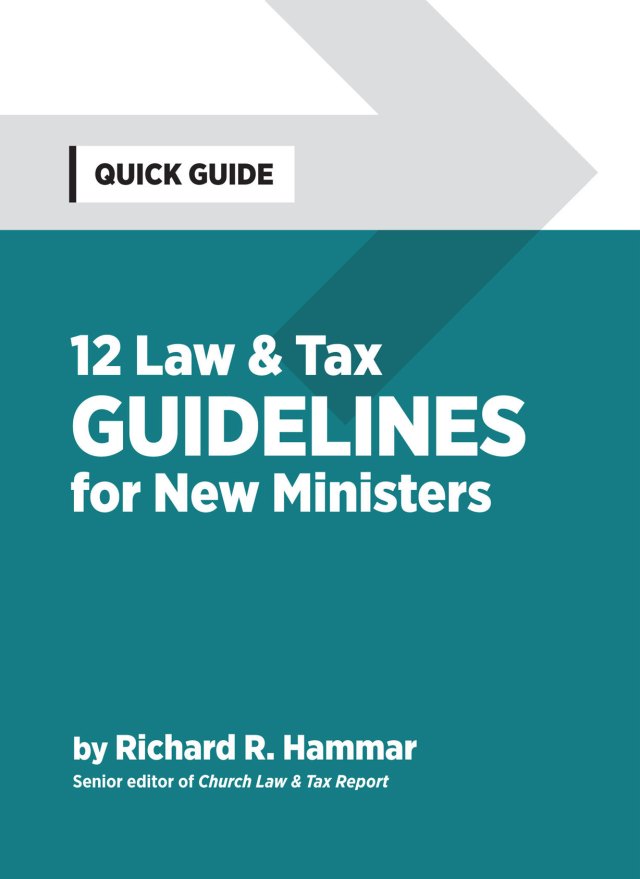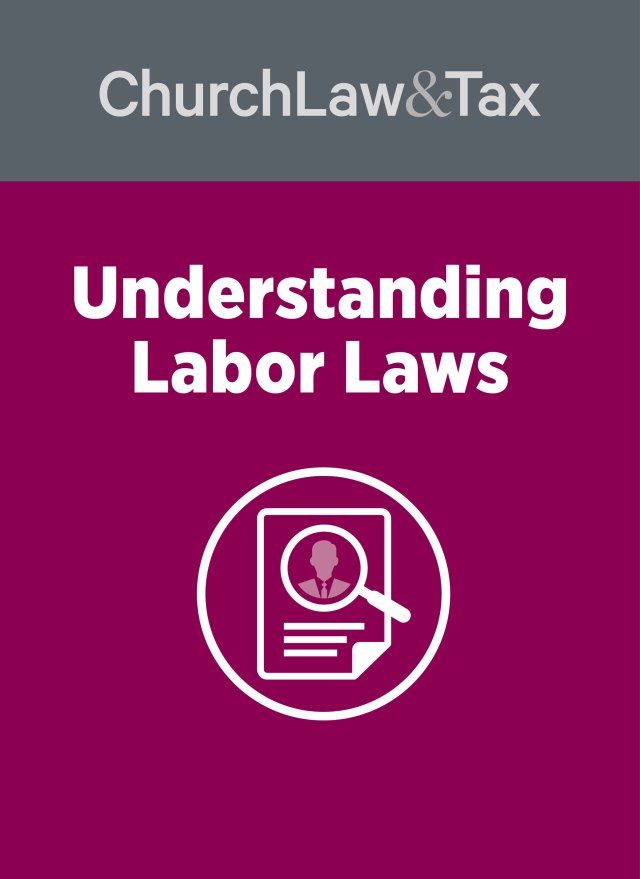The question of whether a minister should report his or her federal income taxes as an employee or as a self-employed person is one that has generated a good deal of controversy. It is a significant question for many reasons, including the following:
- Employees report their compensation directly on Form 1040, and claim unreimbursed business expenses on Schedule A only if they itemize deductions and only to the extent that such expenses (together with most other miscellaneous expenses) exceed 2% of adjusted gross income (only 80% of travel and entertainment expenses are counted). Self-employed persons report compensation and business expenses on Schedule C. Business expenses are in effect deductible whether or not the minister itemizes deductions, and are not subject to the 2% floor.
- Adjusted gross income ordinarily will be higher if a minister reports as an employee, since business expenses are deductions from adjusted gross income. Self-employed persons deduct business expenses in computing adjusted gross income. Adjusted gross income is a figure that is important for many reasons. For example, the percentage limitations applicable to charitable contributions and medical expense deductions are tied to adjusted gross income.
- Ministers working for a church or church agency should receive a Form W-2 each year if they are employees, and a Form 1099-MISC if they are self-employed (and receive at least $600 in compensation).
- Favorable tax-deferred annuities offered by nonprofit organizations (including churches) may only be available to employees.
- The disability pay exclusion generally is available only to employees.
- For many years, most ministers reported their income taxes as self-employed persons. This was consistent with the treatment of all ministers as self-employed for social security purposes (with respect to services performed in the exercise of ministry). However, beginning in 1978, the IRS began making statements that were interpreted by some to require ministers to report their income taxes as employees. For example, in Revenue Ruling 80-110, the IRS held that a minister who is “an employee of a church’ may not deduct unreimbursed business expenses on Schedule C but rather must use Schedule A. See also Rev. Rul. 79-78. In Publication 517 (“Social Security for Members of the Clergy and Religious Workers”), the IRS lists a comprehensive example demonstrating how a minister who is “an employee of the church” should report his income and business deductions. These pronouncements led some tax advisors to conclude that the IRS now views all ministers serving local churches as employees rather than as self-employed. Reliance has also been placed on section 3401 (a) (9) of the Internal Revenue Code which states that ministers who are employees of a church are exempt from tax withholding.
- Your editor has always taken the position that the IRS pronouncements mentioned above merely stated the appropriate manner of reporting income and deductions if employee status was assumed, and were not IRS directives requiring all ministers to report their taxes as employees. Publication 517 itself recognizes that it is possible for ministers who are employees of their churches to be self-employed with respect to certain services (baptisms, marriages, funerals, etc.). And, no one seriously questions that full-time evangelists are self-employed for income tax purposes. It is therefore difficult to support sweeping generalizations that all ministers are employees for income tax purposes.
- The best approach to this issue is to treat ministers as employees only if they satisfy the common law employee test adopted by the Treasury Department:
Generally the relationship of employer and employee exists when the person for whom services are performed has the right to control and direct the individual who performs the services, not only as to the result to be accomplished by the work but also as to the details and means by which that result is accomplished. That is, an employee is subject to the will and control of the employer not only as to what shall be done but how it shall be done. In this connection, it is not necessary that the employer actually direct or control the manner in which the services are performed; it is sufficient if he has the right to do so. The right to discharge is also an important factor indicating that the person possessing that right is an employer. Other factors characteristic of an employer, but not necessarily present in every case, are the furnishing of tools and the furnishing of a place to work to the individual who performs the services. In general, if an individual is subject to the control or direction of another merely as to the result to be accomplished by the work and not as to the means and methods for accomplishing the result, he is not an employee. Treas. Reg. sec. 31.3401(c)-1(b). See also Publication 517.
- Determining a particular minister’s status under this somewhat ambiguous test is often difficult. The following additional criteria, contained in the Social Security Handbook, are intended to clarify the common law employee test. They are accompanied by the qualification that “all facts must be weighed and the conclusion must be based on careful evaluation of all the facts and the presence or absence of factors which point to an independent contractor status,” and “any single fact or small group of facts is not conclusive evidence of the presence or absence of control.”
- (1) A person who is required to comply with instructions about when, where, and how to work is ordinarily an employee.
- (2) Training of a person by an experienced employee or by other means is a factor of control and indicates that the worker is an employee.
- (3) Integration of a person’s services into the business operations generally shows that the person is subject to direction and control and accordingly is an employee.
- (4) If the services must be rendered personally by the individual employed, it suggests an employer-employee relationship. Self-employed status is indicated when an individual has the right to hire a substitute without the employer’s knowledge.
- (5) Hiring, supervising, and payment of assistants by the employer generally indicates that all workers on the job are employees. Self-employed persons generally hire, supervise, and pay their own assistants.
- (6) The existence of a continuing relationship between an individual and the person for whom the individual performs services is a factor tending to indicate the existence of an employer-employee relationship.
- (7) The establishment of set hours of work by the employer is a factor indicating control and accordingly the existence of an employer-employee relationship. Self-employed persons are “masters of their own time.”
- (8) If the worker must devote full time to the business of the employer, he or she ordinarily will be an employee. A self-employed person on the other hand may choose for whom and when to work.
- (9) Doing the work on the employer’s premises may indicate that the worker is an employee if the work could be done elsewhere.
- (10) Persons who must follow established routines and schedules of the employer ordinarily are employees.
- (11) A requirement that workers submit regular oral or written reports to the employer is indicative of an employer-employee relationship.
- (12) An employee usually is paid by the hour, week, or month, whereas a self-employed person usually is paid by the job on a lump sum basis (although the lump sum may be paid in intervals in some cases).
- (13) Payment by the employer of the worker’s business or travel expenses suggests that the worker is an employee. Self-employed persons usually are paid on a job basis and take care of their own incidental and business expenses.
- (14) The furnishing of tools and materials by the employer indicates an employer-employee relationship. Self-employed persons ordinarily provide their own tools and materials.
- (15) The furnishing of all necessary facilities (equipment and premises) by the employer suggests that the worker is an employee.
- (16) Workers who are in a position to realize a profit or suffer a loss as a result of their services generally are self-employed, while employees ordinarily are not in such a position.
- (17) A person who works for a number of persons or organizations at the same time is usually self-employed.
- (18) Workers who make their services available to the general public are usually self-employed. Individuals ordinarily hold their services out to the public by having their own offices and assistants, hanging out a “shingle” in front of their office, holding a business license, and by advertising in newspapers and telephone directories.
- (19) The right to discharge is an important factor in indicating that the person possessing the right is an employer. Self-employed persons ordinarily cannot be fired as long as they produce results which measure up to their contract specifications.
- (20) An employee ordinarily has the right to end the relationship with the employer at any time he or she wishes without incurring liability. A self-employed person usually agrees to complete a specific job and is responsible for its satisfactory completion or is legally obligated to make good for failure to complete the job.
- Another important factor, not mentioned in the above list, is the parties’ own characterization of their relationship. For example, if a church and its minister enter into a written contract that specifically characterizes the minister as self-employed, this would be an additional factor to consider. The accompanying illustration is a clause that may be used by a church wishing to characterize its minister as self-employed rather than as an employee. The clause could be inserted in the contract of employment, or simply adopted as a resolution by the church board and included in the board’s official minutes. Keep in mind that such a clause by itself will have little, if any, relevance. It is merely one factor that will be considered, but one that could be given considerable weight in a close case. Of course, a church will offset the effect of such a clause by issuing its minister a W-2 instead of a 1099 form at the end of each year.
- Sample Clause Characterizing A Minister As Self-Employed
- The church board and Rev. Lang agree and intend that Rev. Lang’s status shall be that of a self-employed person rather than that of an employee in view of the board’s determination, based on its review and consideration of all the facts and circumstances, that Rev. Lang does not satisfy the ‘common law employee” test. In particular, it is the board’s conclusion that it does not have the authority to control the methods or means by which Rev. Lang conducts his services on behalf of the church.
- There is no doubt that most ministers will be employees under “common law employee test” discussed above. However, such a conclusion is not automatic. As has already been indicated, traveling evangelists ordinarily are self-employed, as are ministers of local congregations with respect to certain personal services rendered directly to church members (baptisms, marriages, funerals, etc.). Ministers of local congregations may be self-employed with respect to their services on behalf of the church as well, provided that they are not “employees” under the common law employee test. The fact that such a conclusion is entirely possible is illustrated by a recent Tax Court ruling. In Cosby v. Commissioner, T.C. Sum. Op. 1987-141, the Tax Court concluded that a Methodist minister was not an employee of his local church but rather was self-employed, and accordingly could report his church income and all business expenses on Schedule C. The court acknowledged that the common law employee test” had to be applied in reaching a determination as to the minister’s status, and referred to most of the twenty criteria discussed above as helpful guidelines. The court relied upon the following considerations in reaching its conclusion: (1) the minister was “free to use his own methods and style in the day-to-day conduct of his activities” and was clearly ‘his own man and operated free from any substantial control”; (2) the procedures that existed for terminating the minister’s services did “not at all approximate the type of day-to-day supervision and control which is characteristic of an employer-employee relationship” and did not enable the church to “control or direct the details and means by which the desired result was to be accomplished”; (3) the minister’s seminary education represented a substantial capital investment in his profession; (4) the minister’s profession requires considerable skill; and (5) the minister and his church regarded him as self-employed rather than as an employee. The court observed that its conclusion was “bolstered by the fact that neither party, nor our own research, disclosed a single case in which a member of the clergy.., was held to be an employee of either his or her local congregation or of the hierarchical structure of his or her denomination.”
- In summary, a minister’s reporting status for federal income tax purposes will be determined on the basis of the common law employee test. Ministers wanting to report as self-employed persons should have their church so characterize them in their work agreement or contract, and should have the church issue them a Form 1099 rather than a Form W-2 at the end of each calendar year.
- Example. Rev. Perez is a retired minister who serves as an interim minister for churches in a given geographical region that are temporarily in need of ministerial services. Rev. Perez typically spends no more than three months with any particular congregation, is given great freedom with respect to the duties he performs and the manner or method of performance, and its issued a 1099 form by each church. These facts suggest that Rev. Perez could report his income and business expenses as a self-employed person on Schedule C.
- Example. Rev. Linn is a minister of education at First Church. She has a specific job description, her services are under the direct supervision and control of her senior pastor, she is issued a W-2 form each year, and is required to follow prescribed methods in the performance of her duties. These facts strongly suggest that Rev. Linn is an employee for income tax reporting purposes.
- Example. Rev. Green is senior minister at First Church. The church exercise no control over the methods, means, or results of Rev. Green’s services. Much of his work is performed off of church premises. He is issued a 1099 form each year, and his work agreement with the church characterizes him as self-employed. Under these facts, the Tax Court’s ruling in Crosby v. Commissioner (discussed above) suggests that Rev. Green is free to report his income taxes as a self-employed person.
- Example. Rev. Mayfield works in an administrative capacity for a church agency. Ordinarily, ministers who work in such a capacity will satisfy the definition of a common law employee since they are subject to a greater degree of control and supervision with respect to the details and performance of their duties, and accordingly should report their income taxes as employees.
- Example. Rev. Hoyle is a youth minister at First church. Ordinarily, ministers who work in such a capacity will satisfy the definition of a common law employee since they are subject to a greater degree of control and supervision with respect to the details and performance of their duties, and accordingly should report their income taxes as employees.





